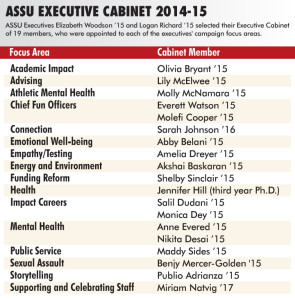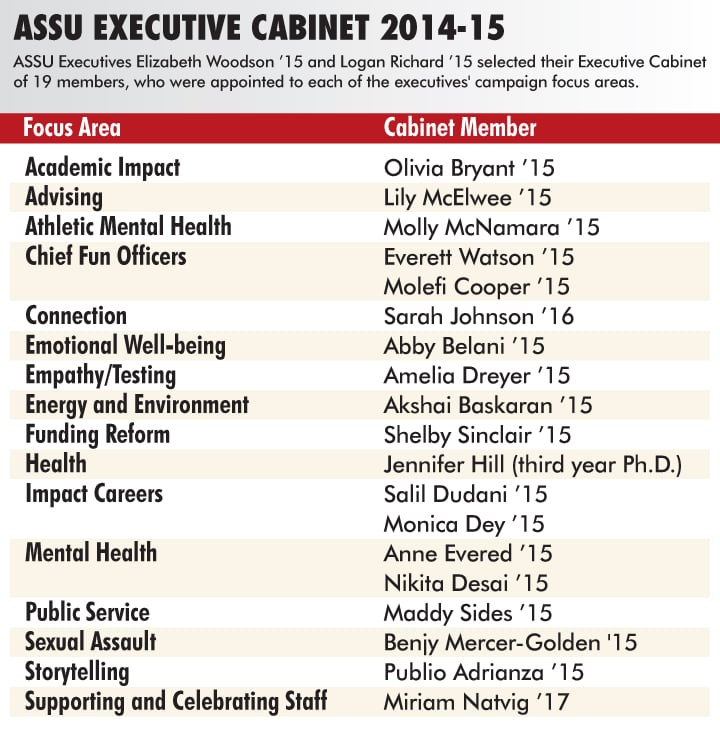
Every ASSU executive’s first official action is filling out their cabinet. Each executive has considerable leeway in determining how to structure their cabinet — from the number of positions to the titles given to each member.
The Daily sat down to talk to the new executives, Elizabeth Woodson ’15 and Logan Richard ’15, to briefly discuss what kind of a team they were forming and the goals and aspirations they have for their cabinet.
The Stanford Daily (TSD): What were you looking for in your cabinet members?
Elizabeth Woodson (EW): We were looking for experts: people that have spent a lot of time working on something they care about, and people that want to tackle big challenges. That was because we do have an ambitious agenda, and that is directly representative of what we heard from the students. All the issues are very connected. After four months of conversations, we knew change was possible with time, and people that cared. And so we’ve been overwhelmed by the degree and outpouring of energy for things that people care about.
Logan Richard (LR): We got 87 applications, drawing from an incredible breadth of knowledge and energy and age. In structuring our cabinet, we have 19 cabinet members with a particular focus on things we identified during our four months of campaigning, such as mental health and how it manifests itself within different communities. So in addition to having a mental health cabinet head, we will be having mental health for athletes. Also, we will focus on a greater amalgamation of connections — connecting students to events, community centers to community centers. We’ve got some superstars across the board. The cabinet heads will be working with action squads. We wanted to work with as many people as possible.
EW: I was on the cabinet last year, and Dan and Billy did an awesome job of giving autonomy. They chose people for projects they knew they wanted to work on and let them run with it. What I learned from the end of [this] year was that I built a team from shared experience and interest and was able to do more in the last two weeks because of these people. So we wanted to start off our cabinet heads with these teams. The two of us cannot do this. Not even 20 of us can do this. So it’s really important that we continue to bring as many people in as we can.
TSD: Are you going to set goals for these cabinet members?
EW: We are going to spend a lot of time sharing our vision and what we see Stanford looking like in a year. From the research we did over the last four months, a lot of solutions to problems came out of that. So we are going to give the cabinet something to run with and experiment with. We will set bigger goals. We are going to be strict about meeting them. We are going to do this [through] testing and constant conversation, because that’s how we feel we were able to do the campaign. We need to continue that.
There are three pieces of the cabinet that we are really excited about: the chief fun officer, the empathy and testing team and the storytelling team. The chief fun officer is in charge of making fun for the campus.
The second is this idea of the testing and empathizing team. We want to get constant stories from students, and they will come in twice a week, and the other groups will come up with questions and t then go to whatever demographic of campus that needs to be understood better just talk to people and get feedback.
The third piece that we are excited about that’s kind of different is focused on storytelling. This was the core takeaway from a couple months of research. We hear these crazy stories and you’re like wow, this is awesome, but that’s the final product. You don’t hear about the years and months and hours that went into them. If we are only hearing the story of the end product, it’s a lot to expect, to be okay with the process and failing and being stressed. That’s a more delicate topic, but we think it’s the beginning of the changing a culture. That group will be focused on video campaigns and starting to tell the story of the end product.
LR: The ability to let your barriers down to share the stories of the processes, the journeys, the failures, the successes, the trials and tribulations is powerful. The idea of promoting a shared idea, a shared consciousness of one’s being, will work towards creating that connection throughout campus. That’s lofty and nebulous within itself, but that’s an aspiration we have.
Contact Andrew Vogeley at avogeley ‘at’ stanford ‘dot’ edu.
